Some Keyhole surgery
This week: Dol Hitchhikers Guide; Stressed out; Drinking fountain; Some Keyhole surgery; The photo detective; He followed us home…; Preserving fruit; Looking back;
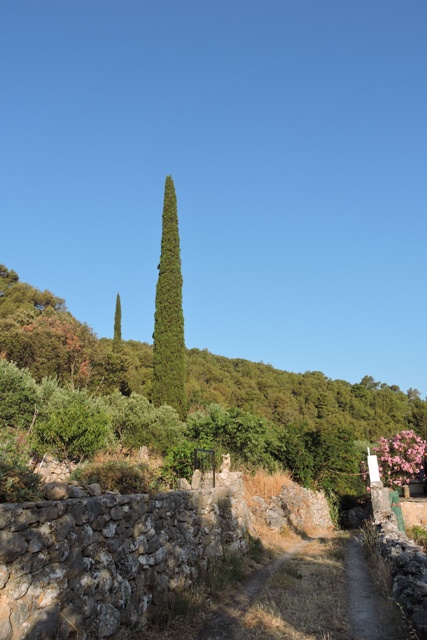
It has been another hot and sticky week this week. However towards the weekend, the weather has cooled slightly and there has been a lovely, refreshing westerly breeze.
Although the temperature has not reached the 36ºC it did last week, it has still been over 34ºC on several days.
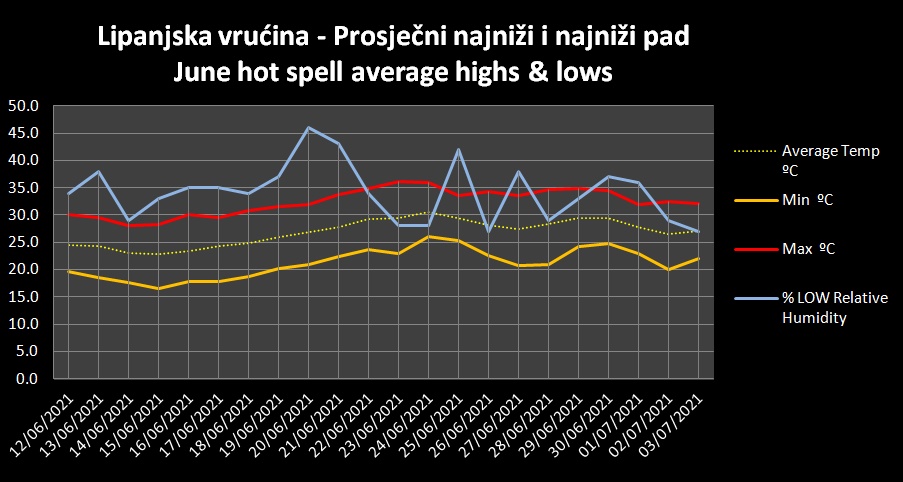
Once the air temperature is above thirty degrees, it is just plain hot. That feeling of heat has been compounded by some significant humidity, 75% on Thursday.
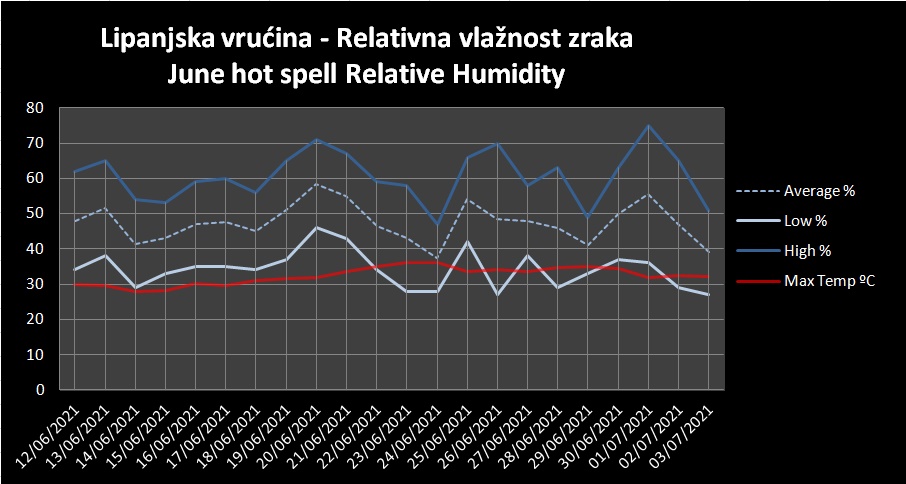
In getting ready for demolishing the wall in the cottage, I decided I should re-locate my wine cellar. Note to the purists: It wasn’t in a cellar, but the pantry was a good, cool substitute.
I bought some of the IKEA bottle storage racks, but because of a lack of space, I’ve never actually used them. So after finding the racking, it was just a case of assembly.
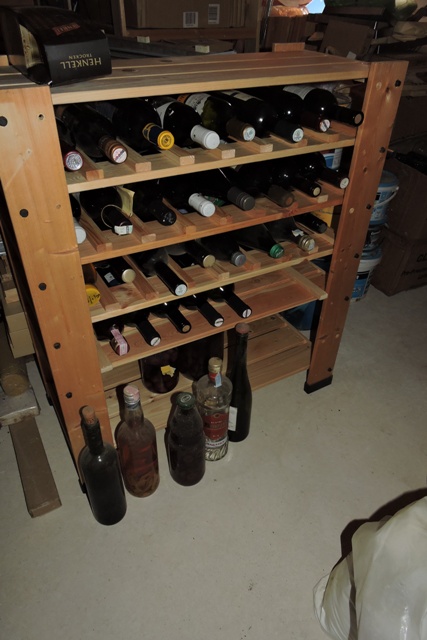
Working inside the cool Konoba, while the temperature was 33ºC outside made me realise just how thermally efficient these old buildings are.
They were built for a purpose: to be where the work was carried out. Whether that was preparing wine from grapes or oil from olives, and then storing the produce.
The builders of 150 years ago certainly knew what they were doing.
It is sad that some of their techniques, things like how they manoeuvred extremely heavy stones into place, has been lost from the living memory. However their workmanship lives on.
Dol Hitchhikers Guide
I often wonder what the people of Dol, 100 years in the future, will think of the work that I and others are doing today?
This will be a time when the sea level has risen and it is no longer a ferry from Split to Stari Grad, but Solin direct to Dol! There will still be people living here, growing grapes and olives and welcoming visitors.
One other job that I have completed this week is to archive all of the Life in a Dol House blog posts. Some things can remain on line for decades, whilst others disappear after a very short time.
Over coffee I was pondering the answer to the ultimate question of life, the universe and everything. The question includes what, if any value, my weekly musings on Life in Dol have, and whether they should be preserved.
The answer to that question is of course 42 .
Archiving is a fancy name for “backing up” data. Archivists of course are skilled professionals, well versed in understanding the future value of something which may present as worthless.
I was surprised when I did some on-line research, that there were vast numbers of pages with every possible reason, for backing up your blog, to prevent accidental data loss etc. But that was the ONLY possible reason.
There was not a single article (or blog) giving authoritative reasons why, or even discussing whether old blogs should be saved.
Perhaps some decades into the future someone in Dol may stumble across this blog. Then they will discover exactly why I have installed both F and G type wall sockets throughout my home….
It is still hot, so I think I’ll just go back to my Hitchhikers Guide to the Galaxy Then I’ll do some more thinking..
PS Not everyone in the world has heard of or read the Hitchhikers Guide to the Galaxy! So just in case you are one, you can listen to the Hitchhikers Guidebook here .
Stressed out
The unusual heatwave that central and southern Europe has been experiencing is taking its toll on plants and trees.
First thing on Monday morning, I was out in the orchard picking Apricots.
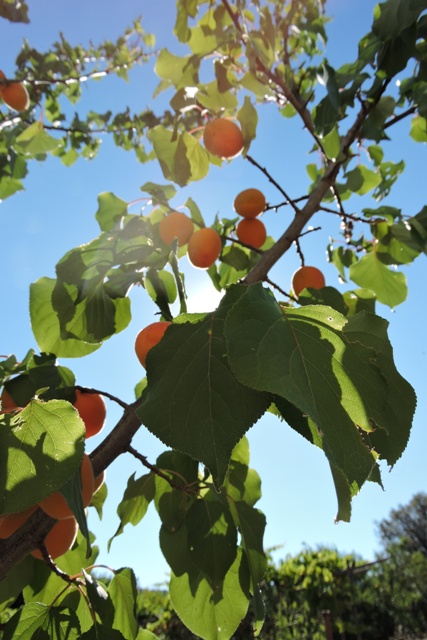
I noticed in my usual walk round that fruit were dropping.
Then I saw that the leaves on the tree were just starting to droop. So it was clearly under heat stress from the dry conditions.
This is a young tree, but it is already three metres tall. When I checked the irrigation system for this tree and the one next to it, there was no water coming out.
Freeing the emitter on one worked and water started to come through, but on the second, even removing the emitter completely didn’t allow any water to flow.
The fruit are almost ripe, certainly ripe enough to pick and use. However they could have benefitted from a little more moisture in the soil to allow them to swell.
During a walk though the olive groves, I saw the same problem with trees devoid of any fruit.
There are deep cracks in the soil where because it is clay based, it has shrunk as the trees have taken all available moisture.
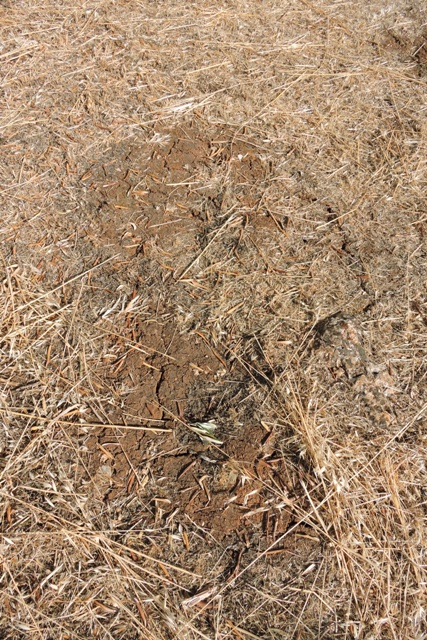
I have lost all my olives. Every single small olive has been aborted by the trees.
This is a self protection mechanism that olives and other fruit bearings trees have when they are stressed.
Growing fruit need a lot of minerals and nutrients, so when they are in short supply, the fruit is aborted to protect the tree.
Like all trees there are different varieties of olive and mine are all Kalamata “Table olives”. These are the sort which get stuffed with piece of red pepper and are eaten with cheese, a salad or with cocktails.
These were oil olives and they are just the same, brown, dead and about to fall from the tree.
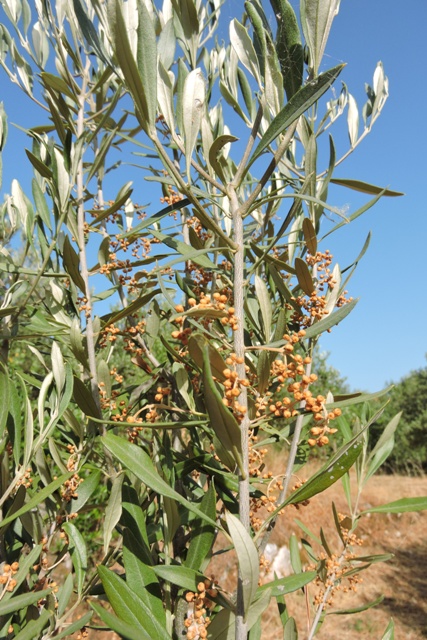
My young Guava has also aborted all it’s fruit. That is especially a shame because Guavas are really nice to eat.
One of my neighbours has his water trailer out every morning and is conveying 1,000 litres of water every day down to his olive trees.
But to him, the production of olive oil is a business, rather than just being for home consumption.
We have had a little less than ⅔ of our normal rainfall so far this year. Almost all of that fell in February, so has now long gone.
Normally in the summer rain cycle, bearing in mind the “normal” Mediterranean climate is ‘Winter mild and wet, summer hot and dry’, we would have received around 110 litres per square metre.
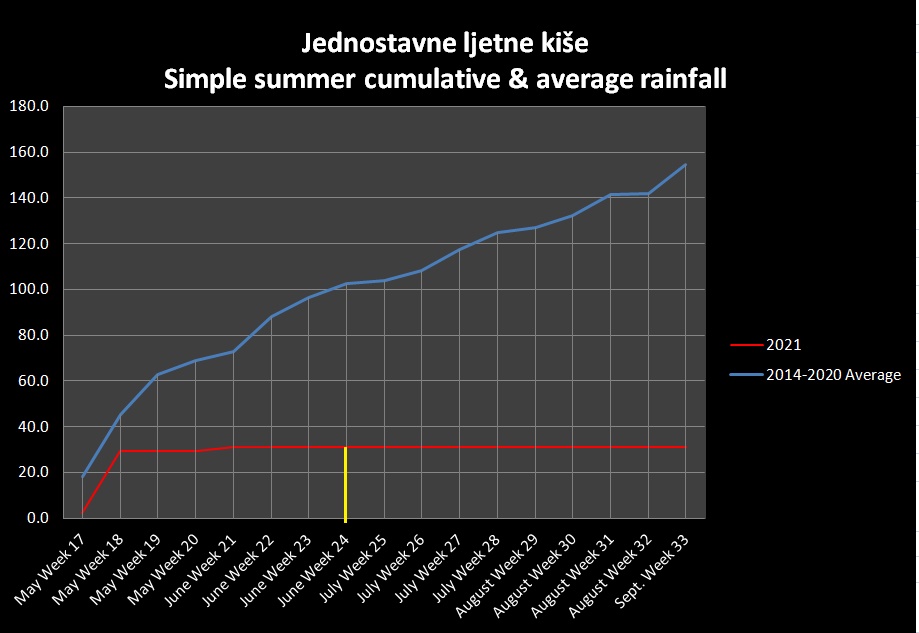
Since May we have had just 30 litres, and all of that fell in early May.
The changing climate is going to materially affect how agriculture and horticulture is carried out in future years.
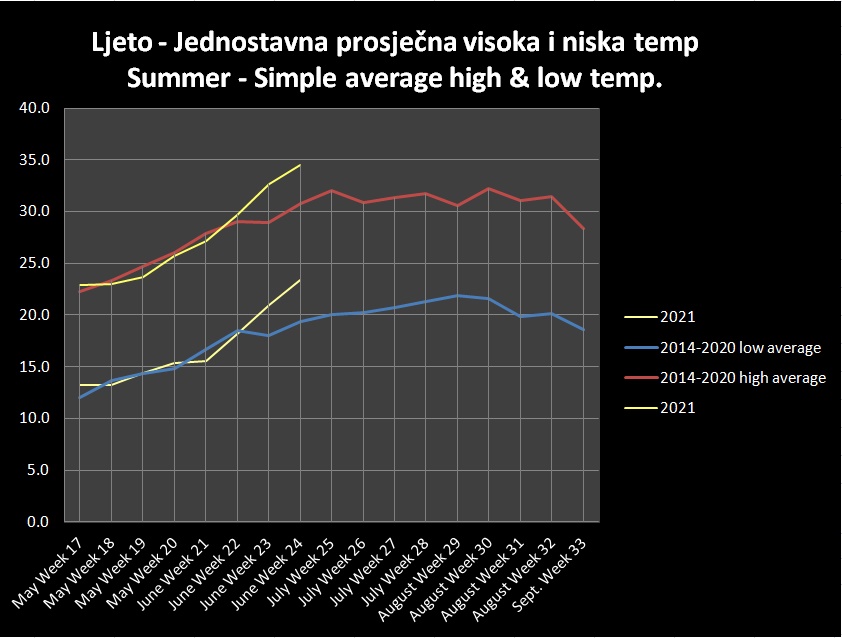
I hope that the young trees that I planted as saplings will be able to extend their roots deep enough into the underlying limestone to allow them to survive.
It has become critically important that I harvest and distribute every drop of rain which falls on my roofs and hard surfaces. This is so that it can be used in the gardens and orchards.
I can only go so far with picking and planting the right varieties for the existing and potential future climatic conditions. The mitigation is to provide limited irrigation, to support the trees when the climate is changing so quickly.
Drinking fountain
It’s not just the trees and plants which get stressed without water, mammals do too.
I have my cold water in the fridge and at the moment. I’m trying to ensure I drink a minimum of three litres of water a day, to compensate for moisture loss through perspiration.
I worry about the felines. A cat can survive without food for several days, but if they become dehydrated, their kidney can quickly shut down. This is a condition which very quickly becomes fatal.
Felines are also known for their liking of moving water. Given the opportunity, most will like to drink from a running tap.
There are several water sources around my Dol house where any of the felines can drink from, as and when they feel thirsty.
In Abu Dhabi there are high temperatures for nine months of the year. I bought an indoor drinking fountain for two reasons.
Firstly because of the drying effect of air conditioning, having a running water source increased the humidity indoors. But secondly, there was a constant source of running water for the felines to drink from, whenever they needed it.
Last October I had found the fountain, still in its box, in the Konoba. Unpacking it, the fountain needed a good clean.
Once dry, I gave it a coat of paint and brought the fountain into the dining room.
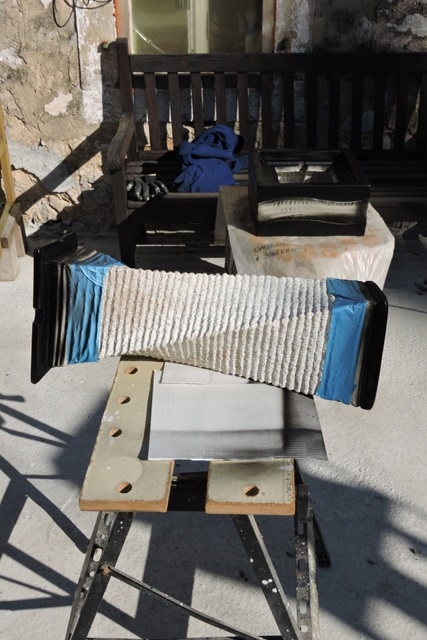
It has been there ever since. So this week I filled the reservoir with water and turned the pump on.
The sound of bubbling water is very soothing. It also caught the attention of the kittens.
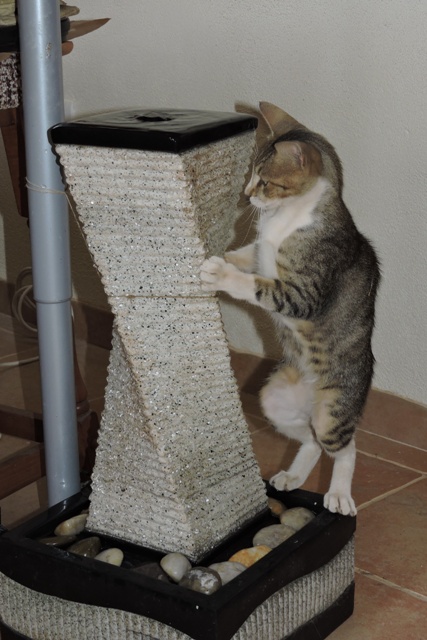
Tigger seems to like it the most. He is a real ‘Water baby’, enjoying pawing and playing with the streams water as well as drinking from it.
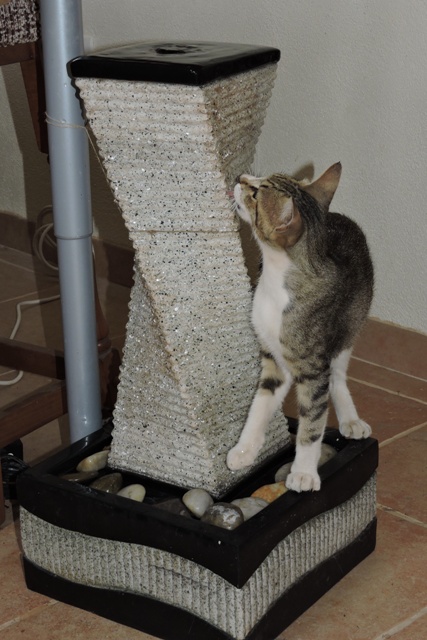
All the felines have been drinking, so every morning I fill the reservoir with fresh water.
The fountain fills a corner under the breakfast bar. As well as being a source of water for parched cats, it also provides indoor humidity on our hottest days.

Some keyhole surgery
I think I am going to fail my examinations for entry into the ALSGBI – the Laparoscopic Surgical Association.
Throughout all my orchards, I have laid a system of underground plastic irrigation pipes. I think that in total I have laid about 200 meters of underground pipe.
Only the last couple of meters where the pipes emerge, near to a tap, are exposed.
This is because I have found through bitter experience that the black pipe when exposed to the harsh Mediterranean sunlight and UV, only last a year to a year and a half at the most. The plastic rots and everything needs to be replaced.
The pipe system starts as regular 13mm diameter pipe at the tap. Then they each run to a ‘T’ piece so the actual pipes go round in a circle to equalise pressure and water output throughout the pipe’s range.
Underground the pipe is not susceptible to sunlight damage and plastic decay. However it does mean that when there is a problem, it requires some digging together with the knowledge of the network, to find the source of the problem.
Pieces of microbore pipe with individual drip emitters at the end, run to all the individual trees. But microbore can become blocked as can the tiny drip emitters.
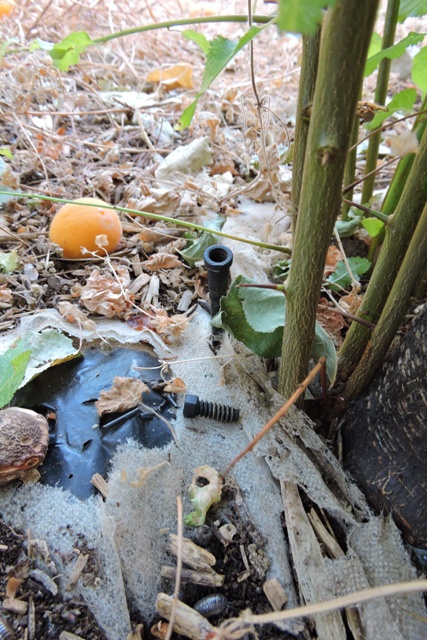
Because of this, you have to be inventive when it comes to dealing with problems.
If you have an “over pressure” event, which blows a connector out of a pipe, it is easy to find. The worst case scenario is that you have a fountain sprouting, somewhere very close to the pipe.
A simple leak can be spotted because all the plants round about the leak, especially the weeds, suddenly turn bright green and grow. This is when everything else around is brown and parched.
A blocked pipe calls for another of those tools that are on my workshop shelf: A coil of thin, plastic coated wire.
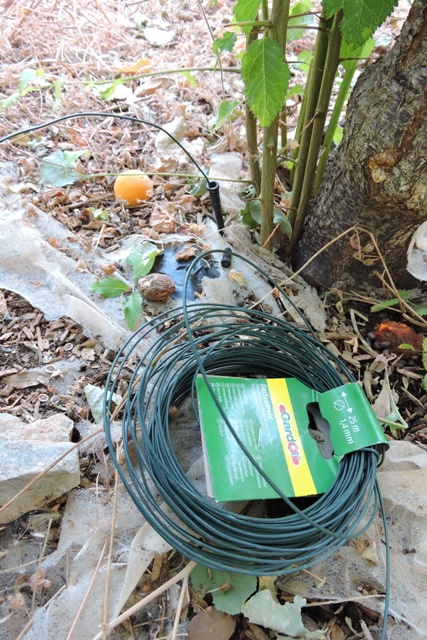
With the emitter removed, it is easy to slowly feed the thin wire down the pipe. Generally the branch from the main pipe is between one and two meters away from each tree.
This means they are far enough away so the tree’s roots shouldn’t become a problem, but close enough so that there is less chance of the microbore pipe becoming blocked.
I could get the wire almost a meter into the pipe before it came to an absolute stop. Nothing I did would free the blockage.
Plan ‘B’ is to carefully excavate, so you don’t damage the underground pipe.
I found that the Apricot tree has developed a massive root ball in the vicinity of where the microbore leaves the feeder pipe. Because of these thick roots I couldn’t access that part of the pipe.
My suspicion is that a root has compressed the microbore to the point where no water can now get through.
I decided that the easiest option would be to put a new piece of microbore into the feeder pipe, away from the roots.

This means that I don’t damage any of the root system of a tree, which is already under stress from not getting enough water.
A few minutes later and for minimal cost, I had the new pipe in place and the emitter providing water to the tree.
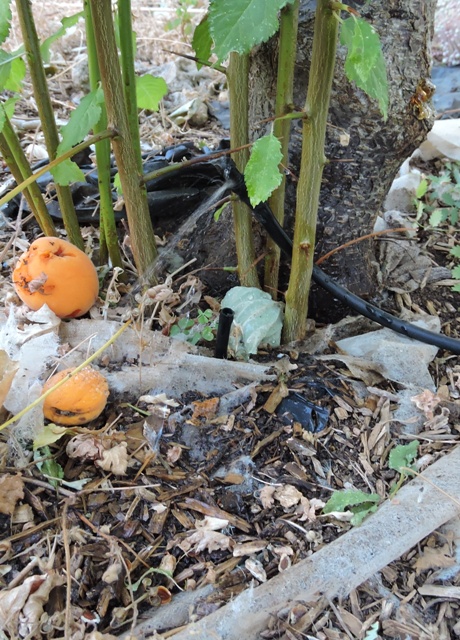
The photo detective
After mentioning last week that Jure, the District Surveyor had left little marking pins in various places, to aid future remeasuring, on one of my walks I realised that I could no longer see one of the pins.
I knew roughly where it was, but in six years a lot of vehicles have passed over the spot.
On a hot and sticky afternoon, I went through some old email message and found the date when Jure had done the initial survey.
It was then just a seconds job to go to my digital photos for that month and find the images I had taken of the marks.
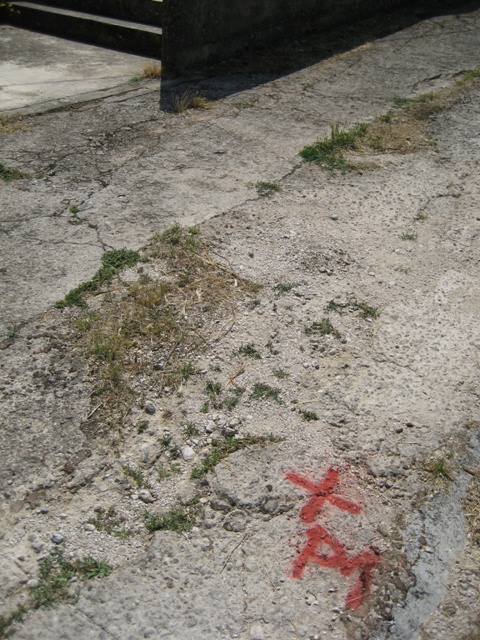
Why had I taken the photographs?
Well firstly, with a digital camera, it cost nothing to take as many photographs as you want. Secondly, I have tried to record everything I have done here at my Dol house.
This is not just for me, but for those who will come in the future and to help me when I am working on another project.
Whether that project is clearing a blocked irrigation pipe, or something much larger, just having previous images, from different angles, can help in locating utilitiy pipes and services, or just where to drill a hole to hang a picture.
Checking the photo, I saw it had been taken at 13:38 on the 8th June. So I went back and took another photo at the same time and place. However the shadows in the new photo were different.
I realised the time stamp was an hour out. This is because I don’t change the time setting on my cameras when the clocks change each year.
Going back an hour later, the shadows were in the right place this time, so I tried to duplicate the shot.
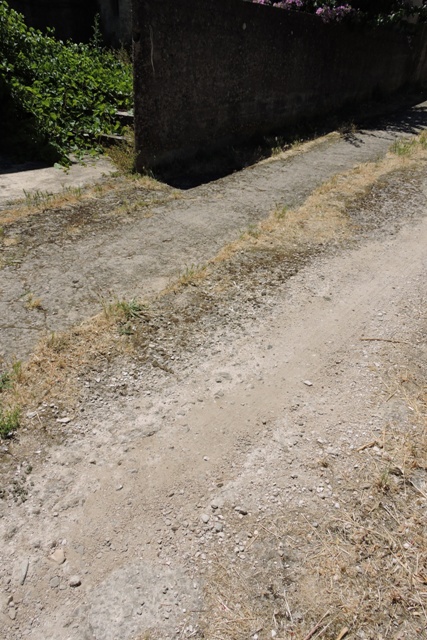
With the photos side by side in Photoshop, I was able to line up the marks in the road surface and pinpoint where the stud should be.
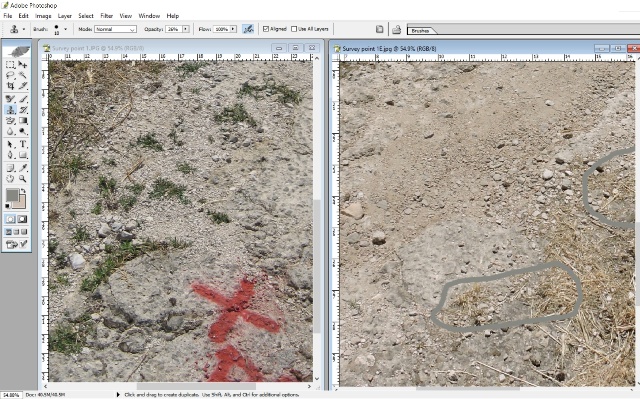
This photo detective work is not difficult on a computer and detailed photographic analysis is one of many courses that I attended when I was in the service. This particular course being run by the RAF, who are the world experts in photo examination.
On my next walk I cleared a little dust and debris and found the stud immediately.
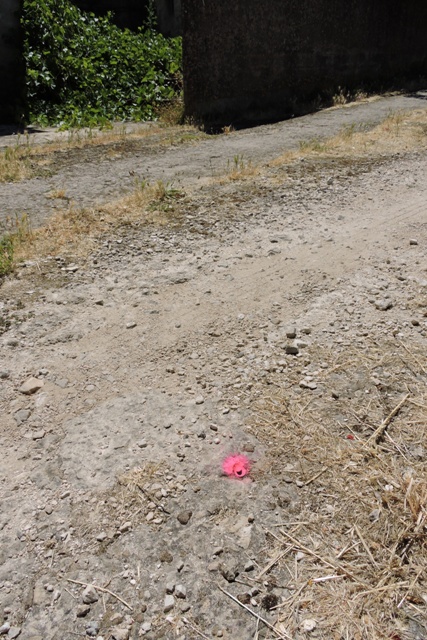
I am expecting another visit from Jure before too long. This is because a re-measure is required as part of the bureaucratic process of getting planning permission for my building work.
If I have the previous points already marked out, it will save him some time…..
He followed us home, can we keep him?

Cartoon by Ron Delgardo in the New York Times
I was talking to my neighbours over the fence on Wednesday evening when I heard the distress call of a kitten.
Almost all of the animal kingdom have a sound which they make when they are in pain, anguish or distress. Kittens have a high pitched, long duration “miew” that they make when they want their Mum.
With my neighbour, we went looking and found a small ginger Tom in an oak coppice which abuts the donkey track.
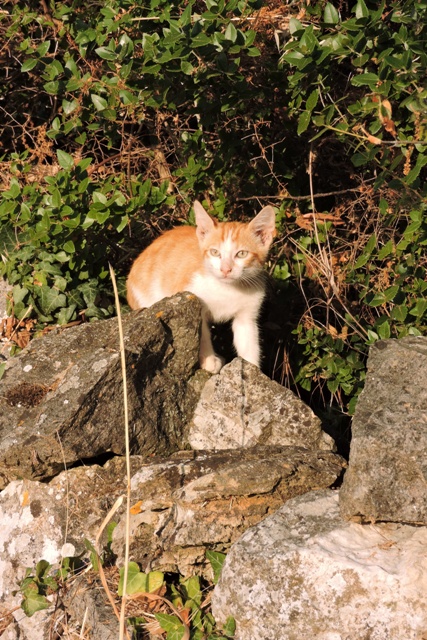
Between us we brought some food and water, which he eagerly attacked.
There are few ginger cats about and I wasn’t aware of any of the local females which had made a nest. I had also not heard him crying when I was out walking with my felines.
He has clearly lost his Mum, whether she has abandoned him to fend for himself, as they do, or she has been killed, I don’t know.
He let me pick him up and I could feel his bones under his fur, so he has not been eating for a while.
My felines were curious, even the older cats didn’t show any aggression.
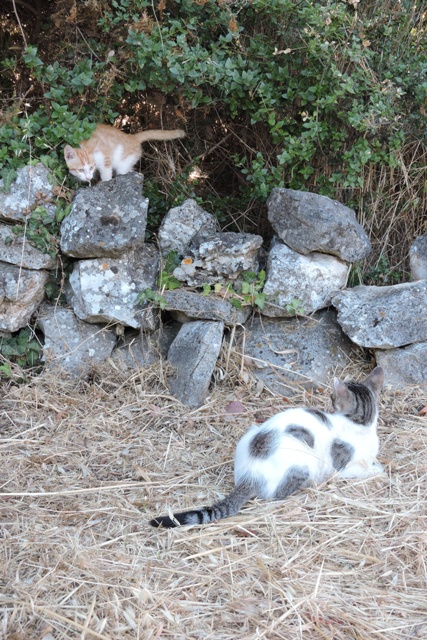
For now he is eating and drinking, appears healthy with a nice clean coat and no sores or scars. I think he is probably only 8 weeks old.
This afternoon walking the short distance from my gate to the coppice to see if he was OK, my neighbour was already there providing him with food and drink.
I think ‘Slama‘ would probably be a nice Croatian name for him. It means ‘straw’ or ‘thatch’ which is his colouring. Or he could get the name Đumbir (Jumbir) which is Ginger in Hrvatski.
I’m hoping my neighbours will adopt him, because I have more than enough to feed at meal times already!
Preserving fruit
My yellow plums have all but finished for this year. The red Myrobalan plums are not quite ready yet, but this week I saw that the Apricots were starting to fall.
I spent some time picking the fruit from my trees, assisted of course by the felines.
A cat, high up in the tree really helps shake ripe fruit off. This fruit of course then falls to the stony hard ground and immediately bruises.
That was not necessarily what I had in mind….
In this part of the village we have good systems for exchanging excess produce, so I took bags of ripe fruit to friends and neighbours. No one else has any plum trees
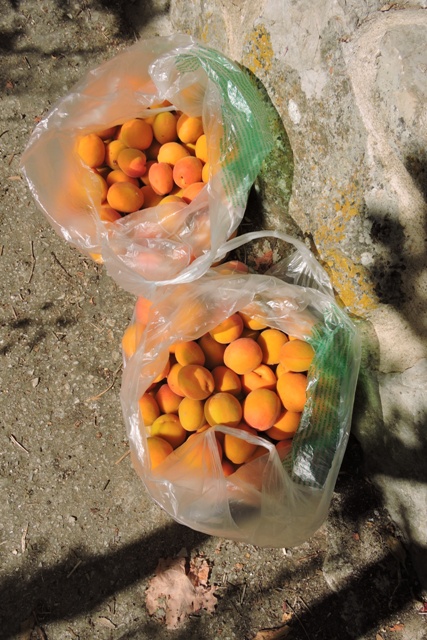
With several kilos of fruit left, I got ready to do some batch processing.
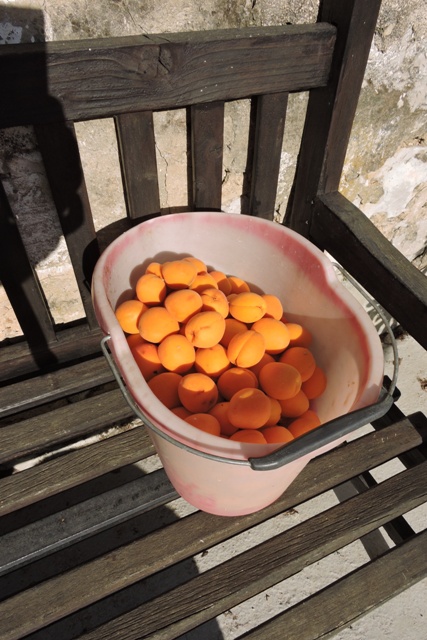
I already have plans for some of the Apricots, things like baking some fruit Galettes later in the summer.
Galettes work best with whole fruits rather than preserved or tinned, because whole are harder. So some Apricots were cut in half and then freeze dried flat in plastic zip-lok bags.
But that still left several kilos to be processed more conventionally for pies.
My big jam pan was pressed into service and several batches of fruit were processed in syrup. They were then placed in sterilised honey jars and the lids were screwed down tight.
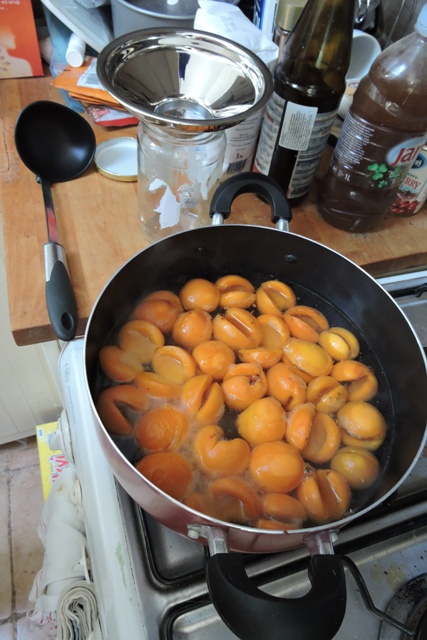
After leaving them overnight, every one had “popped” as the vacuum created by the cooling liquid drew the centre of the lid down and sealed the jar. These will go on the shelf in the Konoba for the winter.
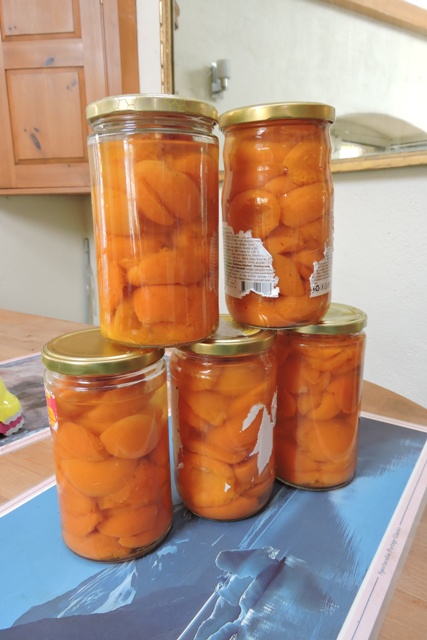
What were left over when there wasn’t enough for another kilogram jar, was eaten with a topping of vanilla ice cream.
As a taster for the winter supplies, I can say they they passed the test with flying colours…
The pan will stay out though. this is because in a week to 10 days, the red plums will be ready for harvesting. NCG
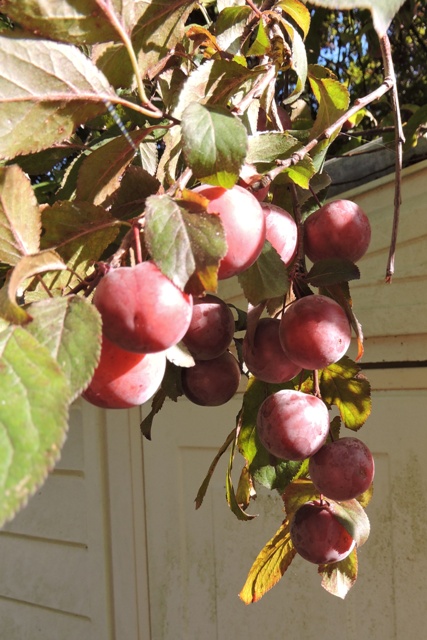
Looking back – Week 26
This is the start of the links to past issues of the blog.
2014/26 Pitter patter of tiny feet
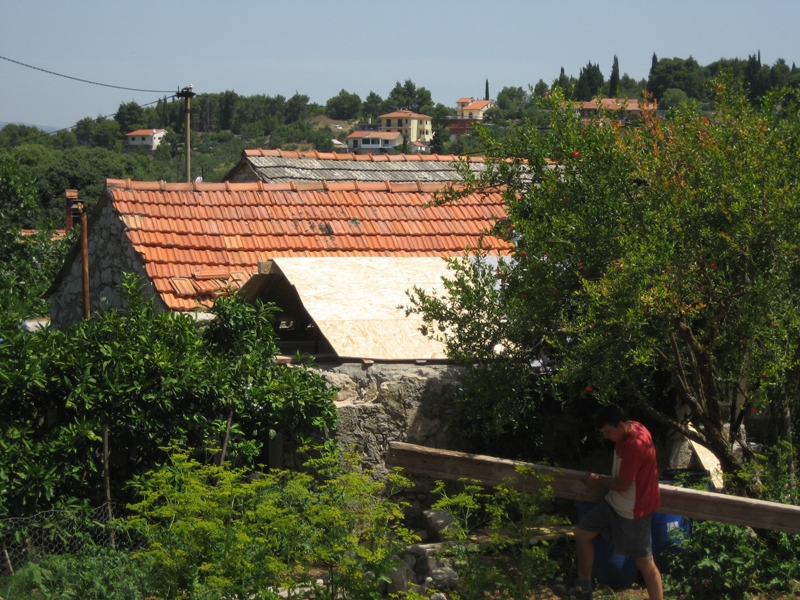
2016/26 How to thrive on neglect
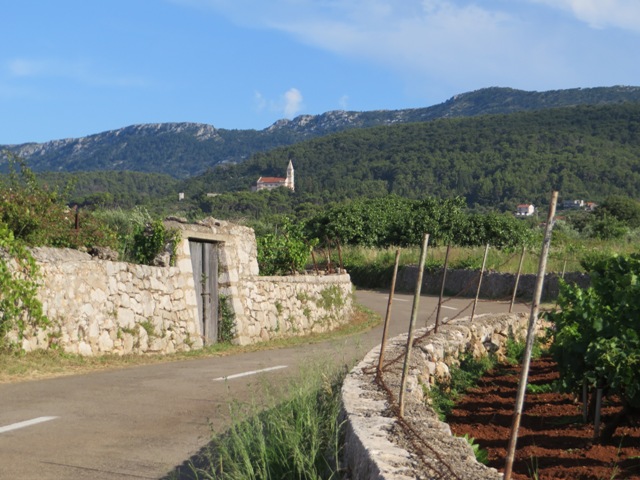
2017/26 This week’s lesson – Don’t wallpaper when it’s +35ºC

2018/26 The kids are shriking
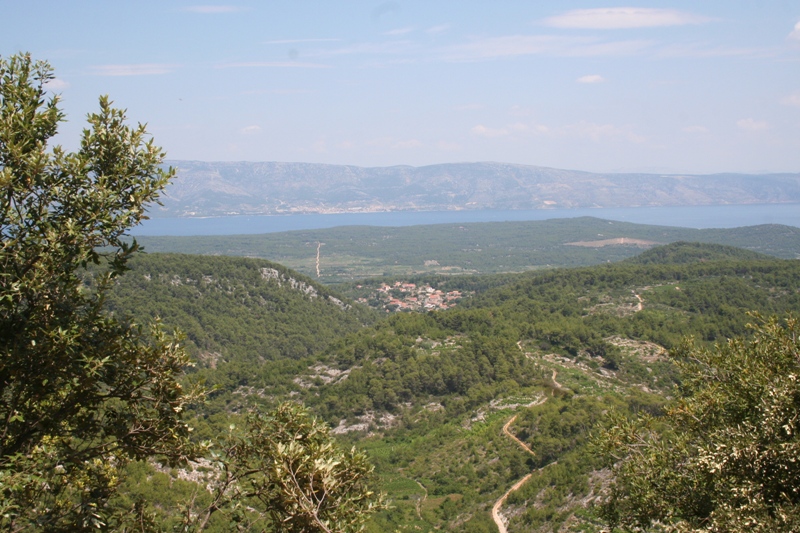
2019/26 A Jamming session

2020/26 Midsummer
